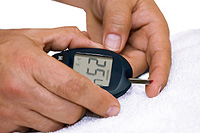Back to: Health Information : Diabetes

CAM and Diabetes: A Focus on Dietary Supplements

Courtesy of The National Institute of Diabetes and Digestive and Kidney Diseases
On this page:
- Introduction
- Key Points
- About Diabetes
- Dietary Supplements and Type 2 Diabetes
- If You Have Diabetes and Are Thinking About Using a Dietary Supplement
- NCCAM-Funded Research
- Selected Sources
- For More Information
Introduction
Diabetes is a chronic condition affecting millions of Americans. Conventional medical treatments are available to control diabetes and its complications. However, some people also try complementary and alternative medicine (CAM) therapies, including dietary supplements. This fact sheet provides basic information on diabetes (with a focus on type 2), summarizes scientific research on the effectiveness and safety of selected supplements that people with diabetes sometimes use, and suggests sources for additional information.
Key Points
- In general, there is not enough scientific evidence to prove that dietary supplements have substantial benefits for type 2 diabetes or its complications.
- It is very important not to replace conventional medical therapy for diabetes with an unproven CAM therapy.
- Tell your health care providers about any complementary and alternative practices you use. Give them a full picture of what you do to manage your health. This will help ensure coordinated and safe care. Medicines for diabetes and other health conditions may need to be adjusted if a person is also using a dietary supplement.
About Diabetes
Diabetes encompasses a group of diseases. Type 2 diabetes accounts for 90 to 95 percent of all diagnosed cases and occurs more frequently in older people. Type 1 diabetes, which accounts for 5 to 10 percent of cases, usually strikes children and young adults. A third form, gestational diabetes, develops in some women during pregnancy.
In all forms of diabetes, the body's ability to convert food into energy is impaired. After a meal, the body breaks down most food into glucose (a kind of sugar), the main source of fuel for cells. In people with diabetes, the body does not make enough insulin—a hormone that helps glucose enter cells—or the cells do not respond to insulin properly. Often, both insulin production and insulin action are impaired. Without treatment, glucose builds up in the blood instead of moving into the cells, where it can be converted into energy. Over time, the high blood glucose levels caused by diabetes can damage many parts of the body, including the heart and blood vessels, eyes, kidneys, nerves, feet, and skin. Such complications can be prevented or delayed by controlling blood glucose, blood pressure, and cholesterol levels.
Type 2 diabetes, the focus of this fact sheet, most often is associated with older age (although it is increasingly being diagnosed in children), obesity (about 80 percent of people with type 2 diabetes are overweight), a family history of diabetes, and physical inactivity. Certain minority population groups are at greater risk, as are women who have had gestational diabetes. Type 2 diabetes usually begins as insulin resistance, a disorder in which cells do not use insulin properly. Symptoms develop gradually and may include fatigue, frequent urination, excessive thirst and hunger, weight loss, blurred vision, and slow-healing wounds or sores. However, it is possible to have type 2 diabetes without experiencing any symptoms.
People with diabetes should try to keep their blood glucose in a healthy range. The basic tools for managing type 2 diabetes are healthy eating, physical activity, and blood glucose monitoring. Many people also need to take prescription pills, insulin, or both.
To find out more about diabetes and related conditions, contact the National Diabetes Information Clearinghouse (see For More Information).
Dietary Supplements and Type 2 Diabetes
Some people with diabetes use CAM therapies for their health condition. For example, they may try acupuncture or biofeedback to help with painful symptoms. Some use dietary supplements in efforts to improve their blood glucose control, manage symptoms, and lessen the risk of developing serious complications such as heart problems.
This section addresses what is known about a few of the many supplements used for diabetes, with a focus on some that have been studied in clinical trials, such as alpha-lipoic acid, chromium, omega-3 fatty acids, and polyphenols.
Alpha-lipoic acid (ALA, also known as lipoic acid or thioctic acid) is an antioxidant—a substance that protects against cell damage. ALA is found in certain foods, such as liver, spinach, broccoli, and potatoes. Some people with type 2 diabetes take ALA supplements in the hope of lowering blood glucose levels by improving the body's ability to use insulin; others use ALA to prevent or treat diabetic neuropathy (a nerve disorder). Supplements are marketed as tablets or capsules.
- ALA has been researched for its effect on insulin sensitivity, glucose metabolism, and diabetic neuropathy. Some studies have found benefits, but more research is needed. (There are some studies, reported from outside the United States, of ALA delivered intravenously; however, this research is outside the scope of this fact sheet.)
- Because ALA might lower blood sugar too much, people with diabetes who take it must monitor their blood sugar levels very carefully.
Chromium is an essential trace mineral—that is, the body requires small amounts of it to function properly. Some people with diabetes take chromium in an effort to improve their blood glucose control. Chromium is found in many foods, but usually only in small amounts; relatively good sources include meat, whole grain products, and some fruits, vegetables, and spices. In supplement form (capsules and tablets), it is sold as chromium picolinate, chromium chloride, and chromium nicotinate.
- Chromium supplementation has been researched for its effect on glucose control in people with diabetes. Study results have been mixed. Some researchers have found benefits, but many of the studies have not been well designed. Additional, high-quality research is needed.
- At low doses, short-term use of chromium appears to be safe for most adults. However, people with diabetes should be aware that chromium might cause blood sugar levels to go too low. High doses can cause serious side effects, including kidney problems—an issue of special concern to people with diabetes.
Omega-3 fatty acids are polyunsaturated fatty acids that come from foods such as fish, fish oil, vegetable oil (primarily canola and soybean), walnuts, and wheat germ. Omega-3 supplements are available as capsules or oils (such as fish oil). Omega-3s are important in a number of bodily functions, including the movement of calcium and other substances in and out of cells, the relaxation and contraction of muscles, blood clotting, digestion, fertility, cell division, and growth. In addition, omega-3s are thought to protect against heart disease, reduce inflammation, and lower triglyceride levels.
- Omega-3 fatty acids have been researched for their effect on controlling glucose and reducing heart disease risk in people with type 2 diabetes. Studies show that omega-3 fatty acids lower triglycerides, but do not affect blood glucose control, total cholesterol, or HDL (good) cholesterol in people with diabetes. In some studies, omega-3 fatty acids also raised LDL (bad) cholesterol. Additional research, particularly long-term studies that look specifically at heart disease in people with diabetes, is needed.
- Omega-3s appear to be safe for most adults at low-to-moderate doses. Safety questions have been raised about fish oil supplements, because some species of fish can be contaminated by substances such as mercury, pesticides, or PCBs. In high doses, fish oil can interact with certain medications, including blood thinners and drugs used for high blood pressure.
Polyphenols—antioxidants found in tea and dark chocolate, among other dietary sources—are being studied for possible effects on vascular health (including blood pressure) and on the body's ability to use insulin.
- Laboratory studies suggest that EGCG, a polyphenol found in green tea, may protect against cardiovascular disease and have a beneficial effect on insulin activity and glucose control. However, a few small clinical trials studying EGCG and green tea in people with diabetes have not shown such effects.
- No adverse effects of EGCG or green tea were discussed in these studies. Green tea is safe for most adults when used in moderate amounts. However, green tea contains caffeine, which can cause, in some people, insomnia, anxiety, or irritability, among other effects. Green tea also has small amounts of vitamin K, which can make anticoagulant drugs, such as warfarin, less effective.
Other supplements are also being studied for diabetes-related effects. For example:
- Preliminary research has explored the use of garlic for lowering blood glucose levels, but findings have not been consistent.
- Studies of the effects of magnesium supplementation on blood glucose control have had mixed results, although researchers have found that eating a diet high in magnesium may lower the risk of diabetes.
- There is not enough evidence to evaluate the effectiveness of coenzyme Q10 supplementation as a CAM therapy for diabetes; studies of its ability to affect glucose control have had conflicting findings.
- Researchers are studying whether the herb ginseng and the trace mineral vanadium might help control glucose levels.
- Some people with diabetes may also try botanicals such as prickly pear cactus, gurmar, Coccinia indica, aloe vera, fenugreek, and bitter melon to control their glucose levels. However, there is limited research on the effectiveness of these botanicals for diabetes.
If You Have Diabetes and Are Thinking About Using a Dietary Supplement
- Tell your health care providers about any complementary and alternative practices you use. Give them a full picture of what you do to manage your health. This will help ensure coordinated and safe care. Medicines for diabetes and other health conditions may need to be adjusted if a person is also using a dietary supplement. For tips about talking with your doctor about CAM, see information on our Time to Talk campaign.
- Women who are pregnant or nursing, or people who are thinking of using supplements to treat a child, should consult their health care provider before using any dietary supplement.
- Do not replace scientifically proven treatments for diabetes with CAM treatments that are unproven. The consequences of not following one's prescribed medical regimen for diabetes can be very serious.
- Be aware that the label on a dietary supplement bottle may not accurately reflect what is inside. For example, some tests of dietary supplements have found that the contents did not match the dose on the label, and some herbal supplements have been found to be contaminated.
NCCAM-Funded Research
NCCAM-supported research includes projects studying the effects of:
- Chromium on glucose control and vascular function
- Yoga in people at risk for diabetes
- Ginkgo biloba extract on diabetes medicines
- EGCG on the body's response to insulin
- Reiki on diabetic neuropathy and heart function.
Also, researchers in the Diabetes Unit of NCCAM's Division of Intramural Research (DIR) are studying many aspects of diabetes, including what happens when the body does not properly react to insulin. DIR-sponsored clinical trials include studies of the effects of vitamin C, glucosamine, and dark chocolate on the body's response to insulin.
Selected Sources
- National Institute of Diabetes and Digestive and Kidney Diseases. Diabetes Overview. National Diabetes Information Clearinghouse Web site. Accessed at www.diabetes.niddk.nih.gov/dm/pubs/overview/index.htm on January 21, 2008.
- Natural Medicines Comprehensive Database. Product monographs. Accessed on January 21, 2008.
- Halat KM, Dennehy CE. Botanicals and dietary supplements in diabetic peripheral neuropathy. Journal of the American Board of Family Practice. 2003;16(1):47–57.
- Yeh GY, Eisenberg DM, Kaptchuk TJ, et al. Systematic review of herbs and dietary supplements for glycemic control in diabetes. Diabetes Care. 2003;26(4):1277–1294.
- Althuis MD, Jordan NE, Ludington EA, et al. Glucose and insulin responses to dietary chromium supplements: a meta-analysis. American Journal of Clinical Nutrition. 2002;76(1):148–155.
- Balk EM, Tatsioni A, Lichtenstein AH, et al. Effect of chromium supplementation on glucose metabolism and lipids: A systematic review of randomized controlled trials. Diabetes Care. 2007; 30(8): 2154–2163.
- Office of Dietary Supplements. Chromium. Office of Dietary Supplements Web site. Accessed at www.ods.od.nih.gov/factsheets/chromium.asp on January 21, 2008.
- Bonadkdar RA, Guarneri, E. Coenzyme Q10. American Family Physician. 2005;72(6): 1065–1069.
- Agency for Healthcare Research and Quality. Garlic: Effects on Cardiovascular Risks and Disease, Protective Effects Against Cancer, and Clinical Adverse Effects. Evidence Report/Technology Assessment no. 20. Rockville, MD: Agency for Healthcare Research and Quality; 2000. AHRQ publication no. 01-E023.
- Banerjee SK, Maulik SK. Effect of garlic on cardiovascular disorders: a review. Nutrition Journal. 2002;1(1):4.
- Larsson SC, Wolk A. Magnesium intake and risk of type 2 diabetes: a meta analysis. Journal of Internal Medicine. 2007;262(2):208–214.
- Office of Dietary Supplements. Magnesium. Office of Dietary Supplements Web site. Accessed at ods.od.nih.gov/factsheets/magnesium.asp on January 21, 2008.
- Schulze MB, Schulz M, Heidemann C, et al. Fiber and magnesium intake and incidence of type 2 diabetes: a prospective study and meta-analysis. Archives of Internal Medicine. 2007;167(9):956–965.
- Song Y, He K, Levitan EB, et al. Effects of oral magnesium supplementation on glycaemic control in type 2 diabetes: a meta-analysis of randomized double-blind controlled trials. Diabetic Medicine. 2006;23(10):1050–1056.
- Agency for Healthcare Research and Quality. Effects of Omega-3 Fatty Acids on Lipids and Glycemic Control in Type II Diabetes and the Metabolic Syndrome and on Inflammatory Bowel Disease, Rheumatoid Arthritis, Renal Disease, Systemic Lupus Erythematosus, and Osteoporosis. Evidence Report/Technology Assessment no. 89. Rockville, MD: Agency for Healthcare Research and Quality; 2004. AHRQ publication no. 04-E012-2.
- Hartweg J, Farmer AJ, Perera R, et al. Meta-analysis of the effects of n-3 polyunsaturated fatty acids on lipoproteins and other emerging lipid cardiovascular risk markers in patients with type 2 diabetes. Diabetologia. 2007;50(8):1593-1602.
- Hartweg J, Perera R, Montori V, et al. Omega-3 polyunsaturated fatty acids (PUFA) for type 2 diabetes mellitus: review. The Cochrane Database of Systematic Reviews. 2008; (1):CD003205. Accessed on January 28, 2008.
- Letter regarding dietary supplement health claim for omega-3 fatty acids and coronary heart disease. U.S. Food and Drug Administration Web site. Accessed at www.fda.gov on January 21, 2008.
- U.S. Food and Drug Administration. What You Need to Know About Mercury in Fish and Shellfish. U.S. Food and Drug Administration Web site. Accessed at http://www.fda.gov/oc/opacom/hottopics/mercury/backgrounder.html on January 21, 2008.
- Collins QF, Liu HY, Pi J, et al. Epigallocatechin-3-gallate (EGCG), a green tea polyphenol, suppresses hepatic gluconeogenesis through 5'-AMP activated protein kinase. Journal of Biological Chemistry. 2007;282(41):30143–30149.
- Fukino Y, Shimbo M, Aoki N, et al. Randomized controlled trial for an effect of green tea consumption on insulin resistance and inflammation markers. Journal of Nutritional Science and Vitaminology. 2005;51(5):335–342.
- Kim J, Formoso G, Li Y, et al. Epigallocatechin gallate, a green tea polyphenol, mediates NO-dependent vasodilation using signaling pathways in vascular endothelium requiring reactive oxygen species and Fyn. Journal of Biological Chemistry 2007;282(18):13736–13745.
- Mackenzie T, Leary L, Brooks WB. The effect of an extract of green and black tea on glucose control in adults with type 2 diabetes mellitus: double-blind randomized study. Metabolism. 2007;56(10):1340–1344.
- Potenza MA, Marasciulo FL, Tarquinio M, et al. EGCG, a green tea polyphenol, improves endothelial function and insulin sensitivity, reduces blood pressure, and protects against myocardial I/R injury in SHR. American Journal of Physiology, Endocrinology, and Metabolism. 2007;292(5):E1378–E1387.
- Ryu OH, Lee J, Lee KW, et al. Effects of green tea consumption on inflammation, insulin resistance and pulse wave velocity in type 2 diabetes patients. Diabetes Research and Clinical Practice. 2006;71(3):356–358.
About Diabetes
Dietary Supplements: Natural Medicines Comprehensive Database
Dietary Supplements: Articles From Scientific Journals
Chromium
Coenzyme Q10
Garlic
Magnesium
Omega-3 Fatty Acids
Polyphenols
For More Information
NCCAM Clearinghouse
The NCCAM Clearinghouse provides information on CAM and NCCAM, including publications and searches of Federal databases of scientific and medical literature. The Clearinghouse does not provide medical advice, treatment recommendations, or referrals to practitioners.
Toll-free in the U.S.: 1-888-644-6226
TTY (for deaf and hard-of-hearing callers): 1-866-464-3615
Web site: nccam.nih.gov
E-mail:
National Diabetes Information Clearinghouse
A service of the National Institute of Diabetes and Digestive and Kidney Diseases, National Institutes of Health (NIH), the clearinghouse responds to inquiries, offers diabetes publications, and makes referrals. For an alphabetical list of publication topics, go to www.diabetes.niddk.nih.gov/dm/a-z.asp.
Toll-free in the U.S.: 1-800-860-8747
Web site: www.diabetes.niddk.nih.gov
National Diabetes Education Program
The National Diabetes Education Program is sponsored by NIH and the Centers for Disease Control and Prevention, with many Federal, state, and local partners. Its services include information and publications on diabetes.
Telephone: 1-301-496-3583
Web site: www.ndep.nih.gov
PubMed®
A service of the National Library of Medicine (NLM), PubMed contains publication information and (in most cases) brief summaries of articles from scientific and medical journals. CAM on PubMed, developed jointly by NCCAM and NLM, is a subset of the PubMed system and focuses on the topic of CAM.
Web site: www.ncbi.nlm.nih.gov/sites/entrez
CAM on PubMed: nccam.nih.gov/camonpubmed/
Acknowledgments
NCCAM thanks the following people for their technical expertise and review of this publication: Derek LeRoith, M.D., Ph.D., Mount Sinai School of Medicine; Gloria Yeh, M.D., M.P.H., Harvard Medical School; and Michael Quon, M.D., Ph.D., NCCAM.
This publication is not copyrighted and is in the public domain. Duplication is encouraged.
NCCAM has provided this material for your information. It is not intended to substitute for the medical expertise and advice of your primary health care provider. We encourage you to discuss any decisions about treatment or care with your health care provider. The mention of any product, service, or therapy is not an endorsement by NCCAM. |
NCCAM Publication No. D416
June 2008
Note: The PDF file requires a viewer such as Adobe Reader, which you can download free of charge from the Adobe Web site.


